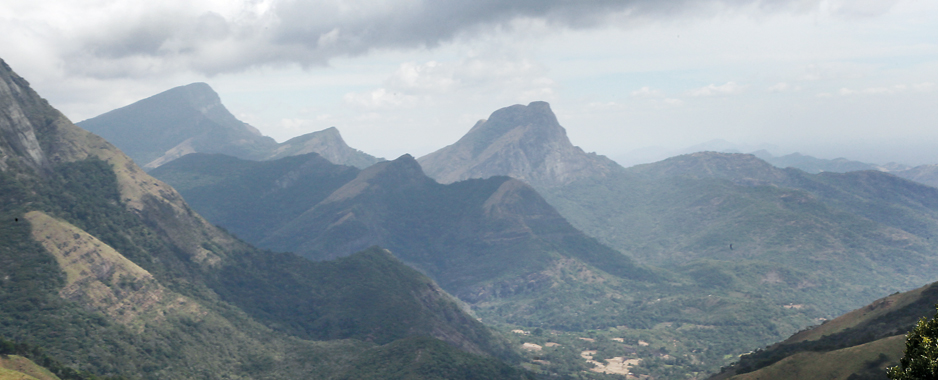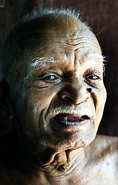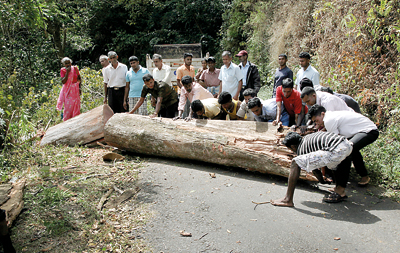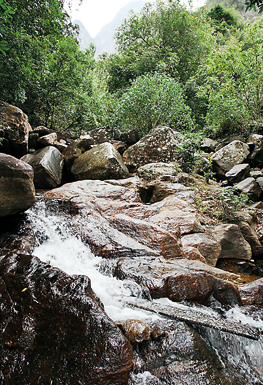Meemure: Stepping into the dim mists of time
There is much excitement in the sleepy little village of Meemure nestling amongst the foothills of the magnificent Knuckles Range.
A huge buffalo with formidable horns is arrogantly trotting along the dusty “main” street running through this village, dubbed the remotest, home to about 120 families.

Set amidst spectacular scenery, it could very well be the remotest village in Sri Lanka, for no mobile phones work here and once the solitary van which leaves this hamlet at 5.30 in the morning returns by 1.30 in the afternoon, all links with the outside world are disconnected except for a rare three-wheeler that makes its arduous way here.
Once the buffalo has joined its peers wallowing in the mud of the recently-harvested paddy fields, a knot of women gather around the Sunday Times team under the massive Mee tree which is the village centre.
Recently, a village lass had her baby on the way to hospital, says K.G. Seelawathie. Having made our tortuous way to Meemure only a few minutes before, we understand the dilemma of anyone who needs to rush to hospital.
No power-lines come to the village and the water is from a spring in the mountain brought to the humble homes by roughly-fashioned pipelines. No one can be seen with a mobile phone pasted to the ear in this village because there’s simply no signal here, with the solitary boutique run by Kusum Kumari Abeyratne boasting a CDMA phone.

Kiri Banda: Oldest man in the village
How far away from modernity it is can be measured by the fact that her boutique does not stock fizzy drinks, but as we sip hot sugary cups of plain tea, the fire-cracker dealer has made his way here to give her fat packets of his wares. “We need to chase away the elephants,” Kusum smiles, stacking a large stock on the shelves, while the weary-looking brinjals and cabbages beg to be put into a pot and cooked.
The quaint manner in which the mail arrives in Meemure seems out of a fairy-tale, when considering the fact that development has spread to the far corners of the country. It is a mail-relay, with the village postman walking six km up the mountain to a spot aptly called “Piyum Wanguwa” between Attalamettuwa and Meemure to handover the outgoing-letters to a colleague, who in turn gives him the incoming letters. Thereafter, the colleague takes the letters to the Thangappuwa post office on the Rangala Road, for distribution.
The village school which teaches children from Grades 1 to 5, has only 20 on its register.The Sunday Times accessed Meemure through Hunnasgiriya on the Kandy-Mahiyangana Road. At Hunnasgiriya, we are told with strong shakes of the head that though we may be able to make it to Loolwatte up the mountain set amidst tea country by car, the balance treacherous 18 km to Meemure itself will have to be by a four-wheel drive vehicle, trishaw, motorcycle or a “paan-baage” van (the tiny van which resembles half a loaf of bread).
The ride up to Loolwatte, passing Mini-World’s End and Corbet’s View, opens up spectacular vistas, with the wind rustling through the grasses on the distant mountains giving the impression of a long somnolent creature trying to shake off its languor. The buses, few and far between, halt at Loolwatte.
The next stretch of tortuous 18 km in a bouncy trishaw needs to be experienced to bring home the reality as no words are adequate. At the top of the mountain at Attalamettuwa is the hulang kapolla or ‘wind-window’ at 600 feet above sea level, where not only are you chilled to the bone but also blown off your feet. “Not a soul in sight”, becomes a startling reality. The descent on the other side opens up a panorama. The sun too decides to play games, throwing the mountains into shade and light.

No rush: Clearing a fallen tree with much laughter. Pix by M.A. Pushpa Kumara
Suddenly we come upon a small crowd of men, women and children who are leisurely watching a few sturdy villagers clear the road of a large tree. Everyone laughs and jokes, while the tree is sawed with an electric saw, bringing to mind the contrasting stress that the Colombo people undergo trying to beat the traffic.
The road to Meemure is over still and sparkling pools dotted with large rocks and overhanging vines, the villagers proudly say was the “scene” for the popular film ‘Sooriya Arana’.
The livelihood of the folk of Meemure is paddy and pepper, complemented by the treacle and jaggery they make after the men climb the tall kitul trees and bring home the sap after tapping the flower.
When asked about the beginnings of this village buried in the dim mists of time, we are propelled to Bellek-gedera Kiri Banda.
One of the two oldest residents of Meemure, nearly-blind Kiri Banda had got his name because he was the first to fix a takarang roof to his home, while everyone else had thatched roofs of straw. Although many are the stories about the beginnings of the village, for 86-year-old Kiri Banda the most plausible seems that it was a “mura-pola” or guard-point from which came Meemure.
Another is that a long, long time ago two men who had come in search of greener pastures from a far-away village, seeing that there was plenty of water and a good climate had decided to settle down here. Later, one of the two early settlers, telling the other that he would remain here only for ‘me mure’ (this period) and not the next, had left the village.
The oldest home in the village is dilapidated and on the verge of collapsing but retains the traditional plan – a well in the meda-midula surrounded by open verandahs.

Idyllic setting: Fed by many a mountain spring
Time seems to stand still, with the Meemure folk still using what their fathers, grandfathers and great-grandfathers used before them. Buffaloes not only plough the land but help harvest the rice by trampling the paddy in the kamatha set amidst the paddy fields. There are no hand-tractors here. Like their forefathers, the paddy is measured with a ‘baage’ (half) and no weighing scales.
This is true for their daily chores as well, with the women sweeping up and collecting the pepper that has been laid out to dry not with brooms or ekel-brooms but with roughly-fashioned bundles of elapath of roots of the plant, bolaththa.
It is E.M.P.G. Navaratne who provides the “rustic village experience” to any local or foreigner who makes his way to Meemure, who shows off the tools and implements such as the pun ketta, kuragan ketta, udu mathaya and taka poruwa that his ancestors used that he safeguards in his home for posterity.
Whether posterity will remain in the village is the fear of many who talk anxiously and vociferously about the restrictions imposed on the clearing of the forest for chena (slash-and-burn) cultivations for kurakkan, bada iringu, mae, mung and valuable enasaal (cardamom).
Enasaal used to bring in a steady income but now that is gone, points out Kiri Banda on behalf of all, lamenting that the young are leaving the village in search of a better livelihood in factories in the towns.
Will Meemure be abandoned as the pressures of modern life overtake the younger generation and the Knuckles Range takes back what may have been its possession all along — this ‘village amid the mountains’? Only time will tell.
Follow @timesonlinelk
comments powered by Disqus





















